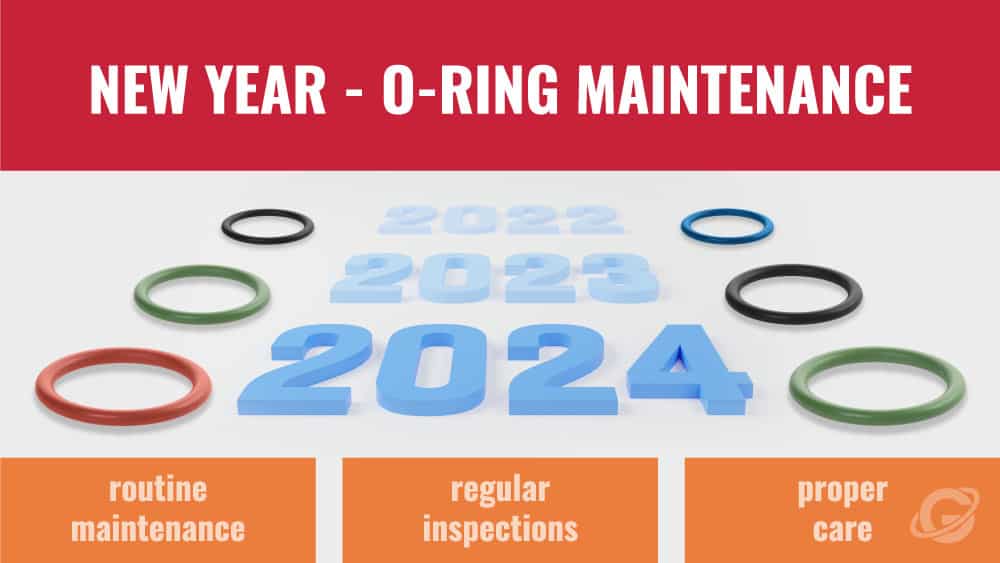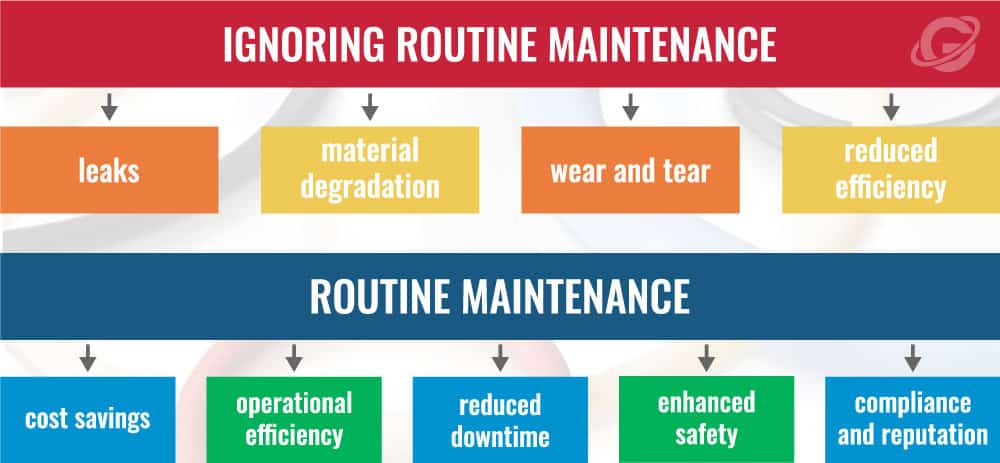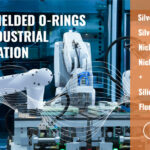
Summary
- Routine maintenance of o-rings is crucial for optimal machinery performance, preventing leaks, and ensuring safety in industrial settings.
- Regular inspections, documentation, and planning are key elements for maintaining o-rings; neglect can lead to increased operational costs and safety risks.
- Proper o-ring care involves cleaning, lubrication, and storage best practices; specialized guidance may be needed for complex issues, ensuring long-term reliability and efficiency.
Introduction
In industrial machinery, the importance of o-rings can easily be overlooked. These seemingly simple components play a critical role in sealing connections, preventing leaks, and ensuring the integrity of a wide range of equipment. Yet, their effectiveness is not permanent and relies heavily on consistent maintenance. This blog highlights why routine o-ring maintenance should be a priority in any industrial setting and provides insights into the best practices for o-ring care, and what to do when it’s time to seek professional help.
The Importance of Routine Maintenance

O-Rings are more than simple circular pieces of rubber; they are key components that ensure the secure sealing of connections in machinery across various industrial settings. Their role in preventing leaks, maintaining pressure, and blocking contaminants cannot be overstated. Yet, their functionality is not a ‘set it and forget it’ aspect. O-Rings are susceptible to various forms of degradation, including material breakdown, physical wear, and chemical reactions.
Neglecting maintenance increases the risk of premature o-ring failure, which not only jeopardizes the effectiveness of the seal but also poses a direct threat to the system’s integrity. In applications where o-rings are sealing hazardous materials, poor maintenance can lead to dangerous leaks or spills, posing health and environmental risks.
Moreover, a well-maintained o-ring contributes to optimal machinery performance. With proper care, you can maximize the service life of an o-ring, thereby getting the most value out of your investment. Regular maintenance ensures that the o-rings continue functioning at peak efficiency, reducing the chances of mechanical failure and, by extension, unscheduled downtime.
Ignoring routine maintenance can lead to problems that can compromise the performance and safety of the o-rings used in machinery. Some common issues include:
- Leaks: Possibly the most immediate and apparent consequences of poor maintenance, which can also lead to further damage and safety risks.
- Material Degradation: Exposure to extreme conditions without proper checks can lead to the material breaking down more rapidly.
- Wear and Tear: Friction and regular use without adequate lubrication or cleaning can wear down the o-ring.
- Reduced Efficiency: A poorly maintained o-ring may not seal effectively, reducing the system’s overall efficiency.
Many organizations might perceive preventative maintenance as an overhead cost without realizing its long-term benefits.
- Cost Savings: Regular maintenance can identify problems before they become major, thereby saving the costs of larger repairs or replacements.
- Operational Efficiency: A well-sealed system operates more efficiently. If seals are compromised, machinery often requires more power to operate or may not work at peak capacity. This can lead to inflated operational costs over time, which can be avoided with regular o-ring checks.
- Reduced Downtime: Downtime is a financial burden and a setback that can compromise your competitive edge. Routine maintenance can significantly reduce the likelihood of unexpected downtimes due to o-ring failure.
- Enhanced Safety: Preventative maintenance can spot vulnerabilities that, if left unaddressed, could lead to accidents or hazardous situations. By mitigating these risks early, you protect your assets and ensure your employees’ well-being.
- Compliance and Reputation: Keeping your o-rings and, by extension, machinery in top shape often ensures compliance with industry regulations. This can be particularly important in industries that adhere to stringent standards, such as food and beverage, pharmaceutical, and aerospace. Maintaining compliance avoids the risk of penalties and enhances your reputation for reliability and quality.
Over the span of a year, o-rings can undergo a significant amount of wear and tear depending on their application. Factors such as pressure fluctuations, temperature variations, and chemical exposure can gradually degrade the material. Regular maintenance schedules should include checks for:
- Surface Erosion: Look for thinning or pitting on the o-ring’s surface.
- Compression Set: The loss of elasticity due to continuous pressure.
- Cracking: Especially common in o-rings exposed to extreme temperatures or corrosive materials.
Proper routine maintenance accounts for these common issues, ensuring your o-rings remain functional and effective for as long as possible.
New Year Preparation Checklist
The start of the New Year is an ideal time for assessing the status of your o-rings and associated maintenance practices. This checklist aims to guide you through this essential process.
Examination and Replacement
Begin by conducting a comprehensive examination of your existing o-rings, checking for signs of wear, cracks, or deformities. Visual inspection can reveal obvious issues, while material integrity tests can provide insights into the o-ring’s resilience and elasticity. Pressure testing can further validate whether each o-ring can still perform to its designated specifications. Based on these evaluations, replace o-rings that are at or near the end of their service life.
Stock and Compound Checks
Next, review your inventory to ensure it’s well-stocked with a variety of compounds like Buna, Viton, Silicone, and EPDM. A diversified inventory is crucial, especially since different applications may require specific o-ring materials. Also, be mindful of the shelf life of each material to avoid using o-rings that may have compromised integrity.
Documentation and Records
Accurate and updated documentation is key. Be sure to log all activities related to the inspection, replacement, and general maintenance of your o-rings. Digital backups of these logs should be kept for easy retrieval and compliance with regulations. Make it a practice to document any incidents of o-ring failure to better understand its root cause and implement corrective actions.
Maintenance Planning
Planning is essential for proactive o-ring care. Establish a comprehensive maintenance schedule for the upcoming year that outlines key dates for routine inspections, pressure tests, and replacements. This schedule should be integrated into the organization’s broader operational calendar to ensure harmonious workflow and mitigate oversight risks.
Tools and Equipment Assessment
The effectiveness of your maintenance efforts partly depends on your tools’ quality. Regularly inspect your tools and measurement equipment for wear and tear, replacing or calibrating as necessary. Consider if any additional tools could improve the efficiency of your maintenance activities.
Risk Assessment
Concluding your New Year preparations should involve a comprehensive risk assessment. Identify potential points of failure in the system where o-rings are deployed. Assess environmental factors like exposure to corrosive chemicals or extreme temperatures, and consider the operational and safety implications of an o-ring failure.
By diligently following the New Year preparation guide, you set the stage for a year of efficient operations and reduced o-ring-related issues.
General O-Ring Maintenance Tips

Preserving the integrity and functionality of your o-rings involves general maintenance practices such as cleaning, lubrication, and proper storage. The frequency of maintenance and disposal process are also important to the general maintenance of o-rings.
Cleaning is a fundamental aspect of o-ring maintenance. Different o-ring materials may require different cleaning agents. For example, mild soap solutions may be suitable for Nitrile (Buna) o-rings, but specialized solvents might be needed for Silicone or Viton o-rings. Always refer to the manufacturer’s guidelines for the correct cleaning agents. Remember that improper cleaning agents can degrade the o-ring material, compromising its performance.
In addition, the right lubrication type can extend your o-rings’ life and make installation easier. Silicone-based lubricants are generally a safe choice for many types of o-rings but may not be suitable for silicone o-rings due to the risk of swelling. The frequency of lubrication depends on the application and environmental conditions; high-pressure or high-temperature applications may require more frequent lubrication.
How you store your o-rings can significantly affect their longevity. Keep o-rings in a cool, dry place away from direct sunlight to prevent degradation from ultraviolet light. Additionally, o-rings should be stored flat to avoid deformities. Always check the manufacturer’s storage recommendations to ensure you meet each material type’s specific requirements.
The maintenance frequency for o-rings is highly dependent on the operational context. For high-wear applications, more frequent checks may be necessary. On the other hand, o-rings should be used in less demanding environments and might only require quarterly or semi-annual inspections. Establishing a routine maintenance schedule and sticking to it can mitigate the risk of unexpected failures.
Finally, responsible disposal or recycling of old or damaged o-rings is good for the environment and can also be a regulatory requirement. Always follow local and federal guidelines for disposing of industrial materials. Some o-ring materials may be recyclable, and specialized waste management services may offer recycling options.
When to Seek Professional Help
There are instances where more than routine maintenance might be required or where issues arise that require specialized knowledge. Sometimes, despite your best maintenance efforts, you may encounter signs that require expert intervention or outright replacement of your o-rings. This could include persistent leaks, unidentifiable material degradation, or frequent o-ring failures. Any of these issues indicate that you should consult an expert for a deeper diagnosis or potentially replace the affected o-rings.
There are various resources for technical support, ranging from online forums and documentation to direct consultation with manufacturers or specialists. The credibility and reliability of the resources should be a major factor in your decision-making. When it comes to sourcing replacement o-rings, the quality and reliability of your supplier are paramount. Look for distributors or manufacturers that offer quality guarantees, have a proven track record, and can provide product certifications.
As a master distributor, Global O-Ring and Seal plays a pivotal role in aiding with these choices. We stock all major compounds and a full range of AS568 standard and metric sizes, making it easier to find the exact o-ring you need. Additionally, our expertise allows us to provide technical support, helping you navigate complex choices and ensuring that you choose the right products for your application.
Conclusion
O-Rings are indispensable components in various industrial applications, and their maintenance should always be considered. By investing time and resources in routine upkeep, you can significantly extend the life of your o-rings, enhance the safety and efficiency of your operations, and ultimately save costs in the long run. Whether conducting regular maintenance checks or considering replacements, Global O-Ring and Seal stands ready to assist you every step of the way.

 English
English  Español
Español  Français
Français  Português
Português  Deutsch
Deutsch  Italiano
Italiano  Русский
Русский  中文
中文  日本語
日本語  العربية
العربية  हिन्दी
हिन्दी 



